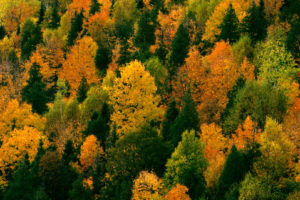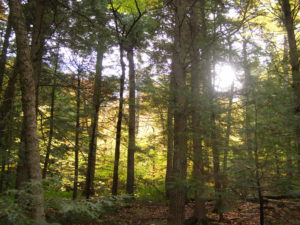Forests and Climate Change
Forests have long played a role in the economy and life of New Brunswick. As a result of climate change, however, we may see some big changes here.
What forests do for us
Forests provide many important services to the province of New Brunswick. They help to moderate temperature in and around our communities. They help protect our water sources, our rivers, streams and wetlands. Plant roots go deep into the soils and slow down soil erosion. Forests slowly absorb snowmelt and rainwater, which can help lessen flooding. They absorb carbon and pollutants from the air, and provide us with cleaner air. In a time of changing climate, with increased temperature and precipitation fluctuations, forests will provide our communities and our natural resources a buffer against the more severe effects. Without diverse forest systems throughout the province, we will end up spending large amounts of money and resources to replace these services they provide us naturally.


What may happen to our forests as a result of climate change?
- An overall increase in temperature and altered precipitation will cause some species to have a harder time growing. The natural ranges for most species are expected to move northward or to higher elevations. Some species currently in their ideal growing zone here in New Brunswick will find themselves in marginal habitat, resulting in poorer growth, and new species of trees and plants may move in and be more competitive.
- Tree growth and regeneration will be affected by extended periods of drought, especially inland. Some trees with shallow root systems, like spruce and hemlock, will be particularly affected. Growth may also be affected by the combination of climate impacts and loss of nutrients in the ground resulting from logging and biomass harvesting.
- There will be an increased likelihood of invasive insects and diseases not normally seen this far north (for example, Hemlock Woolly Adelgid). As a result, we can expect to see more infestations, especially in plantations. This could lead to more calls for using pesticides in our forests, which can create its own set of problems.
- The increased severity in seasonal storms may result in increased damage to our forests, especially in areas where the natural forest structure has been weakened by development or inadequate forestry practices.
